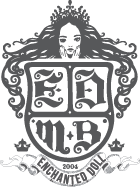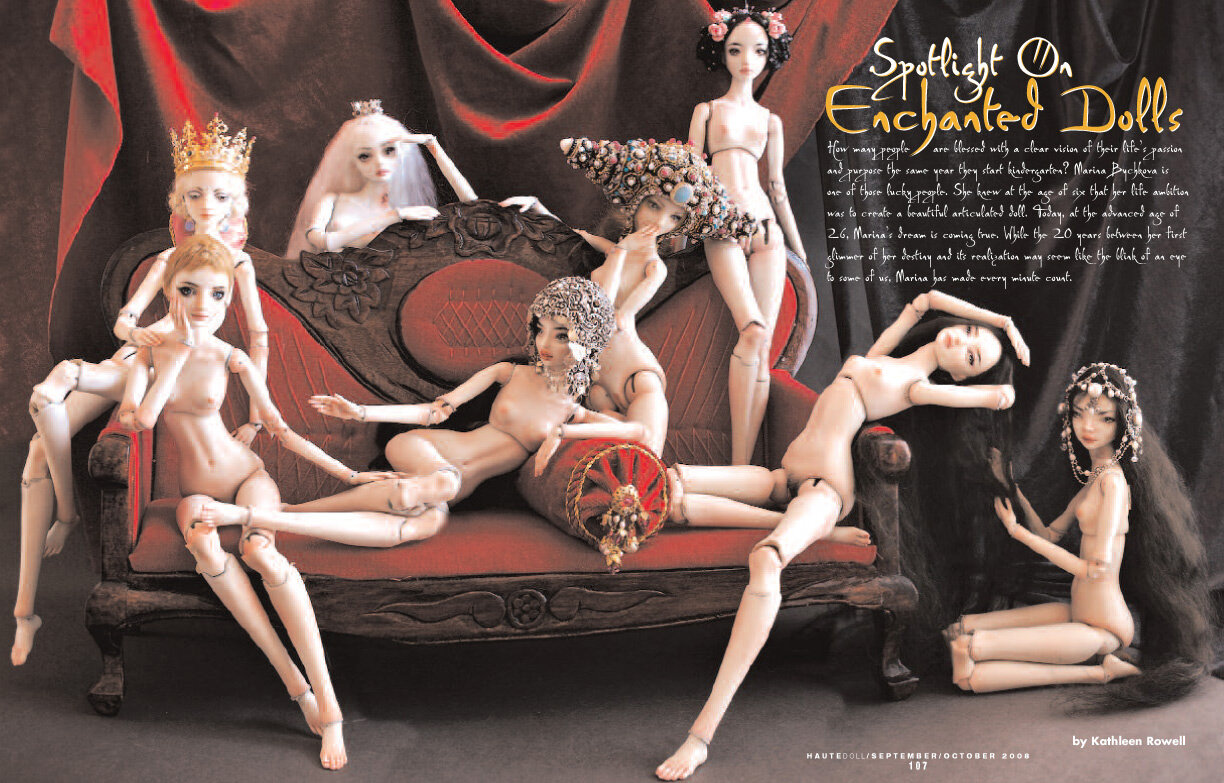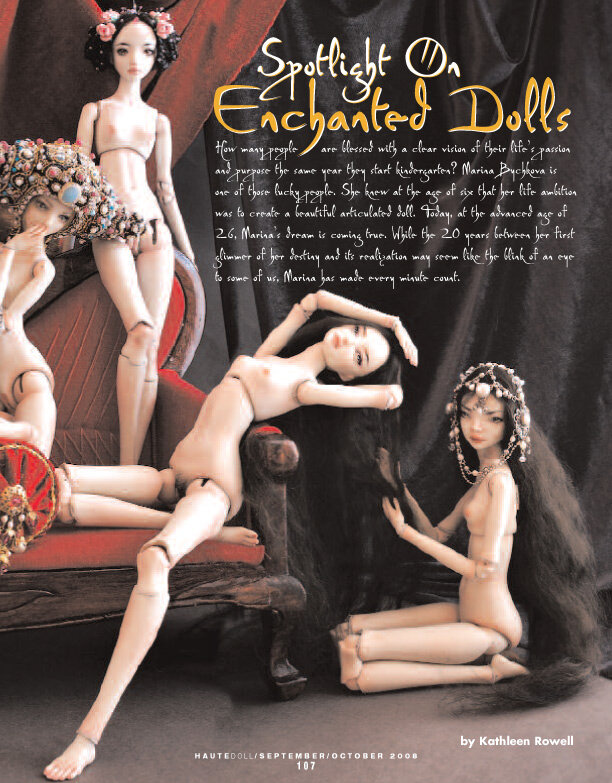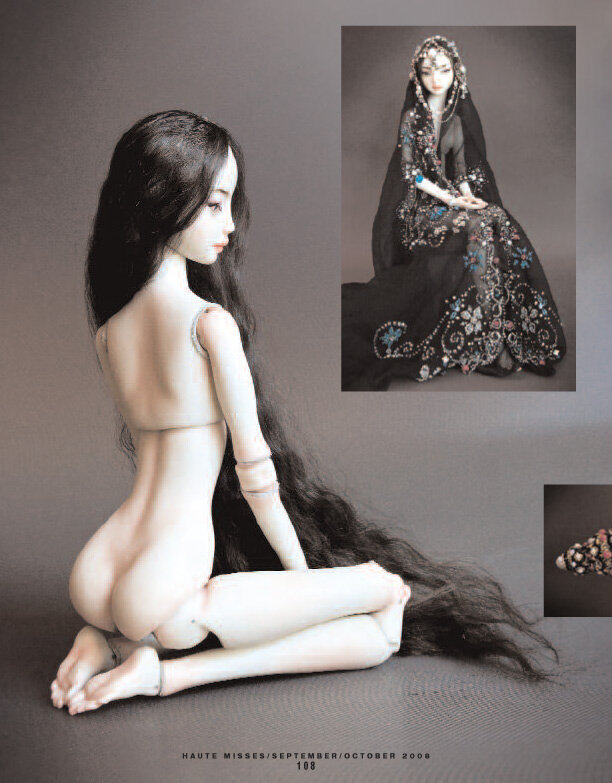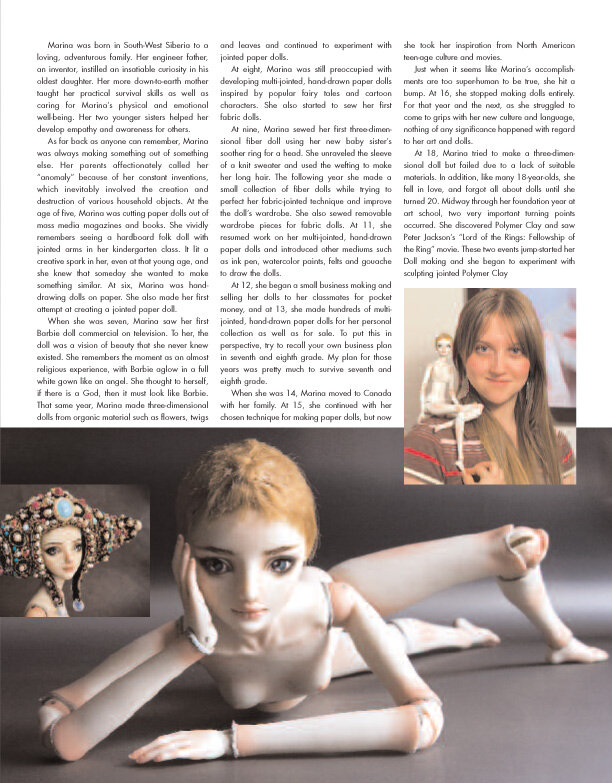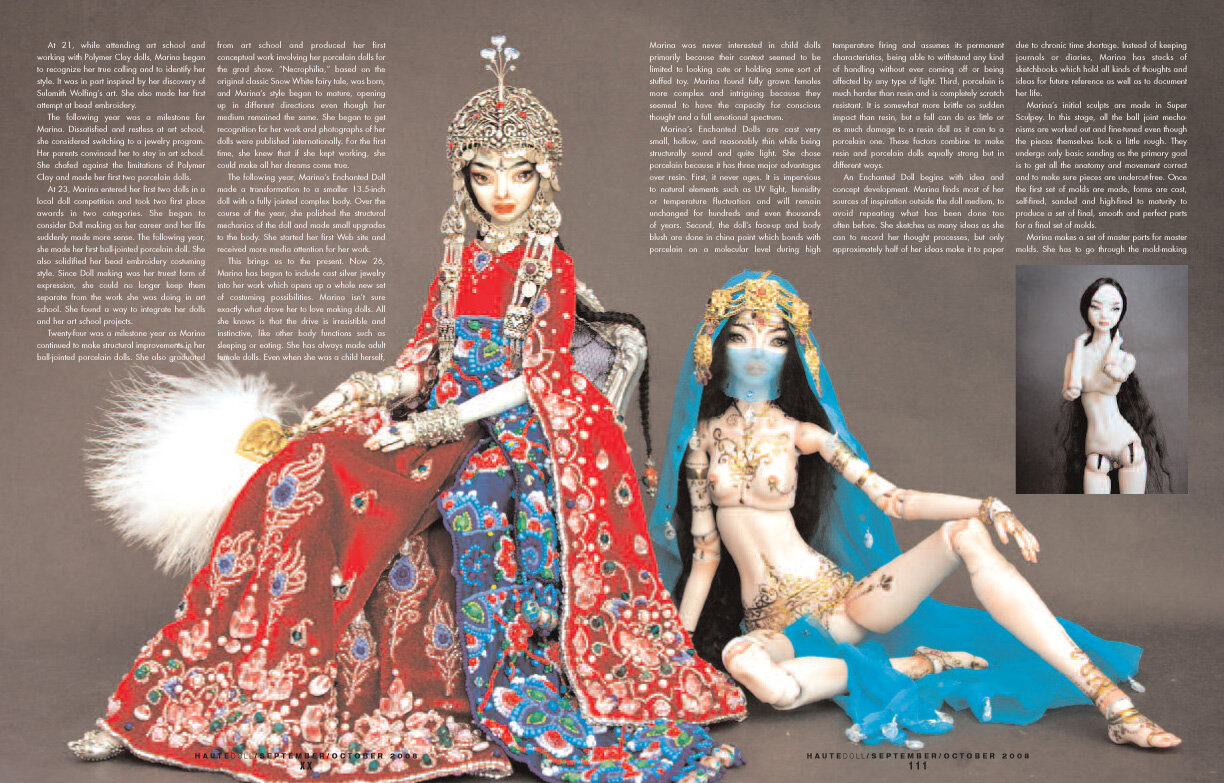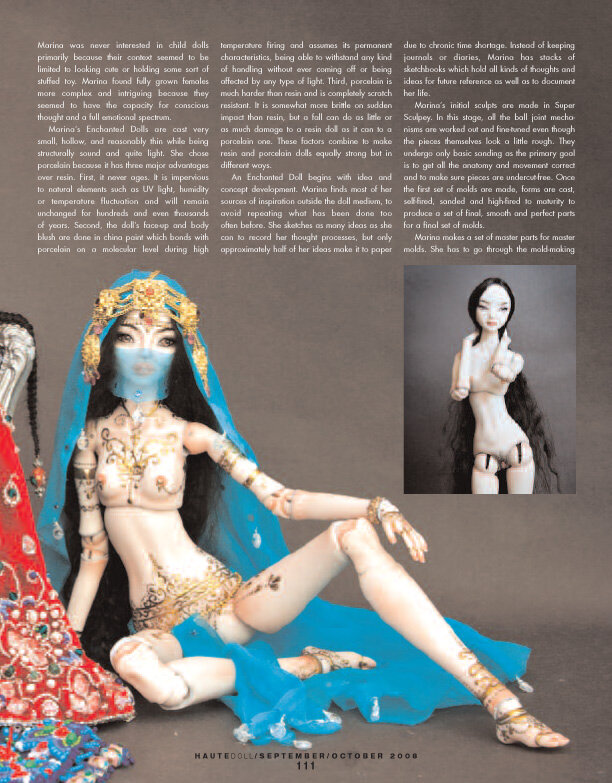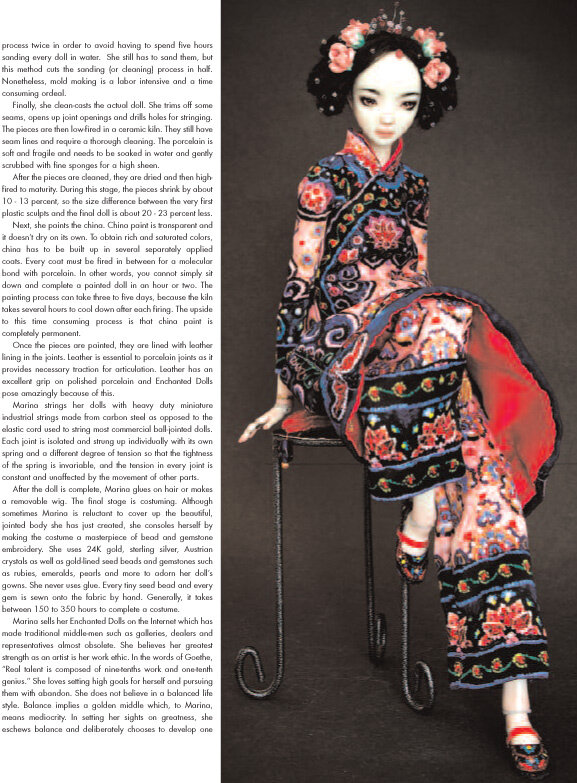2008- HauteDoll Magazine, Sept/Oct Issue, Vol 5. p106-113. Kenosha, USA.
Full Article posted below
Spotlight on Enchanted Dolls – By Kathleen Rowell
How many people are blessed with a clear vision of their life’s passion and purpose the same year they start kindergarden? Marina Bychkova is one of those lucky people. She knew at the age of six that her life ambition was to create a beautiful articulated doll. Today, at the age of 26, Marina’s dream is coming true. While the 20 years between her first glimmer of her destiny and its realization may seem like the blink of an eye to some of us, Marina has made every minute count.
Marina was born in South-West Siberia to a loving, adventurous family. Her engineer father, an inventor, instilled an insatiable curiosity in his oldest daughter. Her more down-to-earth mother taught her practical survival skills as well as caring for Marina’s physical and emotional well-being. Her two younger sisters helped her develop empathy and awareness for others.
As far back as anyone can remember, Marina was always making something out of something else. Her parents affectionately called her “anomaly” because of her constant inventions, which inevitably involved the creation and destruction of various household objects. At the age of five, Marina was cutting paper dolls out of mass medio magazines and books. She vividly remembers seeing a hardboard folk doll with jointed arms in her kindergarten class. It lit a creative spark in her, even at that young age, and she knew that someday she wanted to make something similar. At six, Marina was handdrawing dolls on paper. She also made her first attempt at creating a jointed paper doll.
When she was seven, Marina saw her first Barbie doll commercial on television. To her, the doll was a vision of beauty that she never knew existed She remembers the moment as an almost religious experience, with Barbie aglow in a full white gown like an angel. She thought to herself, if there is a God, then it must look like Barbie. that same year, Marina made three-dimensional dolls from organic material such as flowers, twigs and leaves and continued to experiment with jointed paper dolls.
At eight, Marina was still preoccupied with developing multi-jointed, hand-drawn paper dolls inspired by popular fairy tales and cartoon characters. She also started to sew her first fabric dolls.
At nine, Marina sewed her first threedimensional fiber doll using her new baby sister’s soother ring for a head. She unraveled the sleeve of a knit sweater and used the wefting to make her long hair. The following year she made a small collection of fiber dolls while trying to perfect her fabric-jointed technique and improve the doll’s wardrobe. She also sewed removable wardrobe pieces for fabric dolls. At 11, she resumed work on her multi-jointed, hand-drawn paper dolls and introduced other mediums such as ink pen, watercolor paints, felts and gouache to draw the dolls.
At 12, she began a small business making and selling her dolls to her classmates for pocket money, and at 13, she made hundreds of multijointed, hand-drawn paper dolls for her personal collection as well as for sale. To put this in perspective, try to recall your own business plan in seventh and eighth grade. My plan for those years was pretty much to survive seventh and eighth grade.
When she was 14, Marina moved to Canada with her family. At 15, she continued with her chosen technique for making paper dolls, but now
she took her inspiration from North American teen-age culture and movies.
Just when it seems like Marina’s accomplishments are too super-human to be true, she hit a bump. At 16, she stopped making dolls entirely. For that year and the next, as she struggled to come to grips with her new culture and language, nothing of any significance happened with regard to her art and dolls.
At 18, Marina tried to make a three-dimensional doll but failed due to a lack of suitable materials. In addition, like many 1 8-year-olds, she fell in love, and forgot all about dolls until she turned 20. Midway through her foundation year at art school, two very important turning points occurred. She discovered Polymer Clay and saw Peter Jackson’s “Lord of the Rings: Fellowship of the Ring” movie. These two events jump-started her Doll making and she began to experiment with sculpting jointed Polymer Clay dolls.
At 21, while attending art school and working with Polymer Clay dolls, Marina began to recognize her true calling and to identify her style. It was in part inspired by her discovery of Sulamith Wolfing’s art. She also made her first attempt at bead embroidery.
The following year was a milestone for Marina. Dissatisfied and restless at art school, she considered switching to a jewelry program. Her parents convinced her to stay in art school. She chafed against the limitations of Polymer Clay and made her first two porcelain dolls.
At 23, Marina entered her first two dolls in a local doll competition and took two first place awards in two categories. She began to consider doll making as her career and her life suddenly made more sense. The following year, she made her first ball-jointed porcelain doll. She also solidified her bead embroidery costuming style. Since doll making was her truest form of expression, she could no longer keep them separate from the work she was doing in art school. She found a way to integrate her dolls and her art school projects.
Twenty-four was a milestone year as Marina continued to make structural improvements in her ball-jointed porcelain dolls. She also graduated from art school and produced her first conceptual work involving her porcelain dolls for the grad show. “Necrophilia,” based on the original classic Snow White fairy tale, was born, and Marina’s style began to mature, opening up in different directions even though her medium remained the same. She began to get recognition for her work and photographs of her dolls were published internationally. For the first time, she knew that if she kept working, she could make all her dreams come true.
The following year, Marina’s Enchanted Doll made a transformation to a smaller 13.5-inch doll with a fully jointed complex body. Over the course of the year, she polished the structural mechanics of the doll and made small upgrades to the body. She started her first Web site and received more media attention for her work.
This brings us to the present. Now 26, Marina has begun to include cast silver jewelry into her work which opens up a whole new set of costuming possibilities. Marina isn’t sure exactly what drove her to love making dolls. All she knows is that the drive is irresistible and instinctive, like other body functions such as sleeping or eating. She has always made adult female dolls. Even when she was a child herself.
Marina was never interested in child dolls primarily because their context seemed to be limited to looking cute or holding some sort of stuffed toy. Marina found fully grown females more complex and intriguing because they seemed to have the capacity for conscious thought and a full emotional spectrum.
Marina’s Enchanted Dolls are cast very small, hollow, and reasonably thin while being structurally sound and quite light. She chose porcelain because it has three major advantages over resin. First, it never ages. It is impervious to natural elements such as UV light, humidity or temperature fluctuation and will remain unchanged for hundreds and even thousands of years. Second, the doll’s face-up and body blush are done in china paint which bonds with porcelain on a molecular level during high temperature firing and assumes its permanent characteristics, being able to withstands any kind of handling without ever coming off or being affected by any type of light. Third, porcelain is much harder than resin and is completely scratch resistant. It is somewhat more brittle on sudden impact than resin, but a fall can do as little or as much damage to a resin doll as it can to a porcelain one. These factors combine to make resin and porcelain dolls equally strong but in different ways.
An Enchanted Doll begins with idea and concept development. Marina finds most of her sources of inspiration outside the doll medium, to avoid repeating what has been done too often before. She sketches as many ideas as she can to record her thought processes, but only approximately half of her ideas make it to paper due to chronic time shortage. Instead of keeping journals or diaries, Marina has stacks of sketchbooks which hold all kinds of thoughts and ideas for future reference as well as to document her life.
Marina’s initial sculpts are made in Super Sculpey. In this stage, all the ball joint mechanisms are worked out and fine-tuned even though the pieces themselves look a little rough. They undergo only basic sanding as the primary goal is to get all the anatomy and movement correct and to make sure pieces are undercut-free. Once the first set of molds are made, forms are cast, self-fired, sanded and high-fired to maturity to produce a set of final, smooth and perfect parts for a final set of molds.
Marina makes a set of master parts for master molds. She has to go through the mold-making process twice in order to avoid having to spend five hours sanding every doll in water. She still has to sand them, but this method cuts the sanding (or cleaning) process in half. Nonetheless, mold making is a labor intensive and a time consuming ordeal.
Finally, she clean-casts the actual doll She trims off some seams, opens up joint openings and drills holes for stringing
The pieces are then low-fired in a ceramic kiln They still hove seam lines and require a thorough cleaning The porcelain is soft and fragile and needs to be soaked in water and gently scrubbed with fine sponges for a high sheen.
After the pieces are cleaned, they are dried and then high-fired to maturity. During this stage, the pieces shrink by about 10- 13 percent, so the size difference between the very first plastic sculpts and the final doll is about 20 – 23 percent less.
Next she points the china. China paint is transparent and it doesn’t dry on its own. To obtain rich and saturated colors, china has to be built up in several separately applied coats. Every coat must be fired in between for a molecular bond with porcelain. In other wards, you cannot simply sit down and complete a painted doll in an hour or two. The painting process can take three to five days, because the kiln takes several hours to cool down after each firing. The upside to this time consuming process is that china paint is completely permanent.
Once the pieces are painted, they are lined with leather lining in the joints. Leather is essential to porcelain joints as it provides necessary traction for articulation. Leather has an excellent grip on polished porcelain and Enchanted Dolls pose amazingly because of this,
Marina strings her dolls with heavy duty miniature industrial strings made from carbon steel as opposed to the elastic cord used to string most commercial boll-jointed dolls. Each joint is isolated and strung up individually with its own spring and a different degree of tension so that the tightness of the spring is invariable, and the tension in every joint is constant and unaffected by the movement of other parts.
After the doll is complete, Marina glues on hair or makes a removable wig. The final stage is costuming. Although sometimes Marina is reluctant to caver up the beautiful, jointed body she has just created, she consoles herself by making the costume a masterpiece of bead and gemstone embroidery. She uses 24K gold, sterling silver, Austrian crystals as well as gold-lined seed beads and gemstones such as rubies, emeralds, pearls and more to adorn her doll’s gowns. She never uses glue. Every tiny seed bead and every gem is sewn onto the fabric by hand. Generally, it takes between 150 to 350 hours to complete a costume.
Marina sells her Enchanted Dolls on the Internet which has made traditional middle-men such as galleries, dealers and representatives almost obsolete. She believes her greatest strength as an artist is her work ethic. In the words of Goethe, Real talent is composed of nine-tenths work and one-tenth genius.” She loves setting high goals for herself and pursuing them with abandon. She does not believe in a balanced life style. Balance implies a golden middle which, to Marina, means mediocrity. In setting her sights on greatness, she eschews balance and deliberately chooses to develop one aspect of her life at the expense of others. Specifically, she sacrifices weekends, friends, eight hours of sleep a day, leisure, recreation, free time and hobbies in the name of creative fulfillment. Since dolls are her overwhelming life’s passion, she spends virtually every waking hour working or thinking about the work she will do. Despite her youth, she has a keen sense of mortality and can’t bear to waste a moment or an opportunity.
The people who most influenced Marina’s art include both classic and contemporary illustrators. Sulamith Wulfing tops the list. Wulfing’s work is in the essence of every doll that Marina makes. Kay Nielsen, Edmund Dulac and Arthur Rackum also inspired her as well as Alan Lee, James Christensen, John Howe and Natalia Pieranderi, with whom she had the pleasure of working.
Marina describes her work as highly decorative, figurative, and romantic. Like the art of Sulamith Wulfing, her dolls have a beautiful slightly haunted quality, as if they are caught in the original dark version of a fairy tale (as opposed to the cute Disney version). Marina is fascinated by the implicit sexuality and violence underlying fairy tales, and these undertones are apparent in her work, most notably “Necrophilia.” It is this unique vision as well as Marina’s artistic talent and rigorous aesthetics that imbue her dolls with a quality of edgy, slightly dangerous magic. No other artist is making dolls like this. Marina is truly one-of-a-kind. Marina Bychkova’s dolls can be seen at http://www.enchanteddoll.com.
